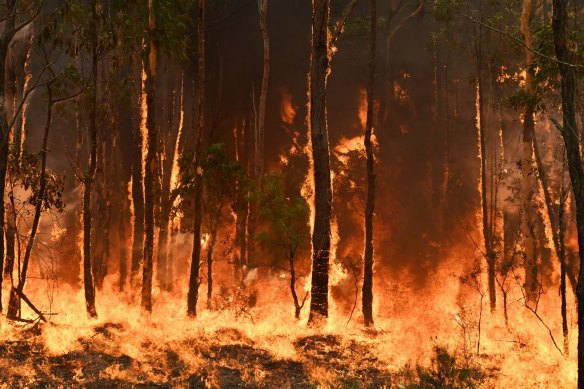Past Conformity: Enhancing Property Safety with an In-depth BAL Report
Past Conformity: Enhancing Property Safety with an In-depth BAL Report
Blog Article
Essential Tips for Bushfire Monitoring to Make Sure Fire Protection

Comprehending Bushfire Danger Levels
Comprehending the varying degrees of bushfire risk is vital for efficient planning and prep work in mitigating potential threats to buildings and lives. Bushfire danger degrees are commonly categorized based upon elements such as climate condition, gas accessibility, topography, and historic fire habits. By comprehending these threat levels, people and communities can proactively execute strategies to minimize susceptability and improve durability despite possible bushfire events.
The very first level of bushfire danger is reduced threat, where the chance of a bushfire occurring and creating significant injury is marginal. Risky levels indicate a significant danger, with problems helpful to rapid fire spread and severe fire actions.
Understanding these bushfire threat degrees allows stakeholders to customize their readiness and feedback activities appropriately, making certain a proactive and effective strategy to bushfire administration.
Establishing a Defensible Space
Reliable bushfire monitoring starts with developing a defensible space around buildings to improve protection against possible fire dangers. A defensible space is a barrier area that creates an obstacle between a framework and the bordering flammable greenery. This space serves as an essential line of defense, giving firemens a secure location to run and assisting to lower the threat of a fire spreading out to the property.
When establishing a defensible room, it is vital to consider the format of the building and the surrounding landscape. Cleaning greenery, specifically extremely combustible plants, within a specific radius of the property can assist protect against the rapid spread of fires. Furthermore, keeping a well-irrigated zone around the residential property can additionally improve its defensibility.
Normal maintenance of the defensible space is essential to ensure its effectiveness. This consists of cutting looming branches, getting rid of dead vegetation, and keeping the area complimentary of debris. By spending time and effort into establishing and preserving a defensible room, residential or commercial property owners can considerably improve their possibilities of protecting their homes and assets during a bushfire.
Applying Fire-Resistant Landscape Design
When making landscapes to minimize the risk of bushfires, incorporating fireproof aspects is necessary for enhancing building security and decreasing fire hazards. Select plants with high wetness material, low oil content, and very little dead plant life to decrease the danger of fire spread.

Producing an Emergency Situation Evacuation Plan
Establishing a comprehensive emergency emptying strategy is crucial for making sure the safety and wellness of individuals during possible bushfire incidents (Bushfire Risk). An efficient evacuation strategy need to outline clear treatments to follow in the occasion of a bushfire threat, including marked evacuation paths, setting up points, and communication methods
To begin producing an emergency situation evacuation plan, it is necessary to evaluate the certain threats and vulnerabilities of your area. Determine several discharge routes that result in risk-free locations far from the fire, thinking about aspects such as surface, road accessibility, and possible risks. Establish see this site interaction channels to alert locals of an approaching evacuation, utilizing techniques such as alarms, text signals, or door-to-door alerts.
Regularly review and exercise the evacuation plan with all homeowners or area participants to make certain every person recognizes their duties and functions. Conduct drills to examine the performance of the plan and make any needed modifications. By having a well-prepared evacuation strategy in location, you can boost the possibilities of a safe and organized evacuation during a bushfire emergency situation.
Preserving Fire Safety And Security Devices
After developing an extensive emergency emptying prepare for bushfire events, it is important to focus on the normal upkeep of fire safety tools to make certain optimal functionality and preparedness. Normal maintenance of fire security tools such as fire extinguishers, smoke detectors, smoke alarm, and automatic sprinkler is crucial in securing lives and residential or commercial property during a bushfire. Carrying out routine inspections, testing, and maintenance of these gadgets by certified professionals is essential to assure they remain in functioning order when required.
Fire extinguishers ought to be inspected routinely for stress degrees, visible damage, and appropriate functionality. Smoke detectors should have their batteries changed a minimum of annually and undergo regular monthly testing to ensure they are functional. Smoke alarm and automatic sprinkler must be checked occasionally to verify they are linked and functioning properly. In addition, it is essential to maintain fire security equipment easily accessible, unblocked, and plainly classified for easy identification during an emergency situation. By vigilantly preserving find fire security devices, individuals can boost their readiness and action capabilities in case of a bushfire.
Verdict
To conclude, efficient bushfire monitoring entails understanding threat levels, producing defensible areas, executing fire-resistant landscape design, developing evacuation plans, and keeping fire safety and security tools. By following these vital pointers, people can ensure much better fire defense and safety for their areas and residential properties. It is crucial to focus on aggressive procedures to alleviate the risks connected with bushfires and to be planned for emergencies.
By recognizing the nuances of bushfire danger degrees, creating defensible rooms, carrying out fire-resistant landscape design, creating detailed evacuation strategies, and ensuring the upkeep of fire security devices, neighborhoods and people can substantially reinforce their durability against the devastations of wildfires - Bushfire Management Plan. These suggestions are not just important for safeguarding versus prompt fire hazards however additionally for cultivating long-lasting fire protection approaches that can make a substantial distinction in the face of rising bushfire threats
Risky degrees indicate a considerable risk, with conditions favorable to fast fire spread and severe fire behavior. Normal upkeep of fire safety tools such as fire extinguishers, smoke detectors, fire alarms, and sprinkler systems is essential in protecting lives and building throughout a bushfire.In conclusion, effective bushfire administration includes understanding threat levels, developing defensible rooms, applying fireproof landscaping, developing emptying plans, and maintaining fire safety and security tools.
Report this page